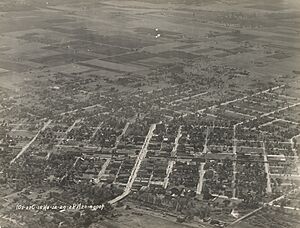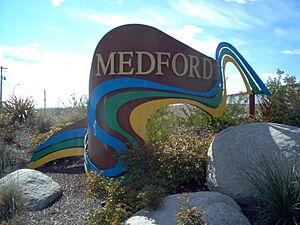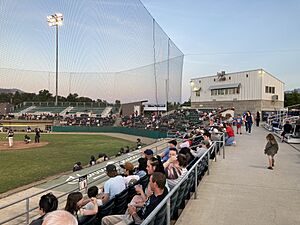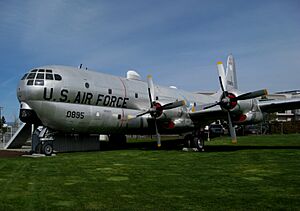Medford, Oregon facts for kids
Quick facts for kids
Medford, Oregon
|
||
|---|---|---|
|
City and county seat
|
||

Clockwise, from top: aerial image of Medford, City Hall, the Medford Carnegie Library, Vogel Plaza, and Bear Creek Park
|
||
|
||
| Nickname(s):
"Pear Blossom City"
|
||
| Motto(s):
"Heart of the Rogue"
|
||
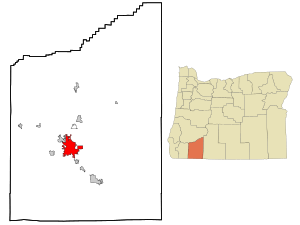
Location of Medford in Jackson County and Oregon
|
||
| Country | United States | |
| State | Oregon | |
| County | Jackson | |
| Area | ||
| • City and county seat | 27.73 sq mi (71.81 km2) | |
| • Land | 27.71 sq mi (71.78 km2) | |
| • Water | 0.01 sq mi (0.03 km2) | |
| Elevation | 1,382 ft (421 m) | |
| Population
(2020)
|
||
| • City and county seat | 85,824 | |
| • Rank | US: 425th | |
| • Density | 3,096.66/sq mi (1,195.61/km2) | |
| • Urban | 154,081 (US: 213th) | |
| • Metro | 223,259 (US: 206th) | |
| Time zone | UTC−8 (PST) | |
| • Summer (DST) | UTC−7 (PDT) | |
| ZIP Codes |
97501, 97504
|
|
| Area codes | 541, 458 | |
| FIPS code | 41-47000 | |
Medford is a city in Jackson County, Oregon, in the United States. It is also the county seat, which means it is the main city where the county government is located.
In 2020, Medford had a population of 85,824 people. This makes it the eighth-largest city in Oregon. The larger area around Medford, called the metropolitan area, has about 223,259 people.
The city was named in 1883 by David Loring. He was a civil engineer for the Oregon and California Railroad. He named it after Medford, Massachusetts, which was close to his hometown. Medford is located near the middle part of Bear Creek.
Contents
- Discovering Medford's Past
- Exploring Medford's Geography
- Understanding Medford's Population
- Medford's Economy and Jobs
- Arts and Culture in Medford
- Parks and Fun in Medford
- Learning in Medford: Schools and Colleges
- Media in Medford
- Sports and Recreation in Medford
- Getting Around Medford: Transportation
- Medford's Sister City
- Famous People from Medford
- See also
Discovering Medford's Past
How Medford Began
In 1883, a team of railroad surveyors arrived in the Rogue Valley. They were looking for the best path for the Oregon and California Railroad. People in nearby Jacksonville hoped the railroad would pass through their town. This would have helped Jacksonville grow a lot.
However, the surveyors decided to build the railroad closer to Bear Creek. This decision was final. By November 1883, a spot for the train station was chosen. A team then started planning the new town. They finished in December 1883, creating 82 blocks for buildings.
Early Buildings and Growth
James Sullivan Howard, a merchant, claimed to have built the first building in January 1884. But a blacksmith named Emil Piel was already advertising his business in December 1883. On February 6, 1884, Howard's store became Medford's first post office. Howard was the first postmaster.
The town of Medford was officially created by the Oregon Legislative Assembly on February 24, 1885. It became a city in 1905.
Modern Changes and Downtown Renewal
In 1927, Medford became the county seat of Jackson County. It took this title from Jacksonville.
In 1967, Interstate 5 was built right next to downtown Medford. This new highway replaced the old Oregon Pacific Highway. Some people say it caused small businesses in downtown Medford to decline. However, it is still a very important road for people traveling through the city.
Since the 1990s, Medford has worked hard to make its downtown area better. This effort is called urban renewal. Many old buildings have been fixed up. These include the Craterian Ginger Rogers Theater and the Cooley-Neff Warehouse. Streets have been changed, and new sidewalks and bike lanes were added. Two new parking garages were also built.
Downtown Medford also got a new library building. It replaced the historic Medford Carnegie Library. Now, both Rogue Community College and Southern Oregon University have satellite campuses downtown.
A big project called The Commons started in 2011. It aims to create more parking, recreation, and businesses downtown. The new main office for Lithia Motors is part of this project. The Commons also includes two public parks for gatherings and events like the farmer's market.
Exploring Medford's Geography
Medford is about 27 miles (43 km) north of the California border. The city covers about 25.74 square miles (66.67 sq km). Most of this is land, with a very small amount of water.
Medford is located in an area that used to have ancient volcanoes. You can see this in the Upper and Lower Table Rock lava formations. Nearby Mount McLoughlin and Crater Lake are also remains of old volcanoes.
Medford's Climate and Weather
Medford is in a rain shadow between the Cascade Range and Siskiyou Mountains. This area is called the Rogue Valley. Because of this, Medford gets less rain and more sunshine than other parts of Oregon.
Medford has a warm Mediterranean climate. Summers are very hot, with many days over 90°F (32°C). Sometimes, temperatures can even reach over 100°F (38°C). Winters are milder, but freezing temperatures can happen.
In winter, Medford sometimes experiences temperature inversions. This means cold air gets trapped under warm air, which can cause thick fog. This fog can last for weeks and lower air quality.
Snowfall in Medford is usually light, averaging about 3.4 inches (8.6 cm) per year. It melts fairly quickly. The wettest month on record was December 1964, with 12.72 inches (323 mm) of rain.
The coldest temperature ever recorded in Medford was −10°F (−23°C) in December 1919. The hottest was 115°F (46°C) in July 1946 and June 2021.
Understanding Medford's Population
| Historical population | |||
|---|---|---|---|
| Census | Pop. | %± | |
| 1890 | 967 | — | |
| 1900 | 1,791 | 85.2% | |
| 1910 | 8,840 | 393.6% | |
| 1920 | 5,756 | −34.9% | |
| 1930 | 11,007 | 91.2% | |
| 1940 | 11,281 | 2.5% | |
| 1950 | 17,305 | 53.4% | |
| 1960 | 24,425 | 41.1% | |
| 1970 | 28,973 | 18.6% | |
| 1980 | 39,746 | 37.2% | |
| 1990 | 46,951 | 18.1% | |
| 2000 | 63,154 | 34.5% | |
| 2010 | 74,907 | 18.6% | |
| 2020 | 85,824 | 14.6% | |
| U.S. Decennial Census | |||
Medford's Growing Community (2020 Census)
| Race / Ethnicity (NH = Non-Hispanic) | Pop 2000 | Pop 2010 | Pop 2020 | % 2000 | % 2010 | % 2020 |
|---|---|---|---|---|---|---|
| White alone (NH) | 54,299 | 59,756 | 61,433 | 85.98% | 79.77% | 71.58% |
| Black or African American alone (NH) | 291 | 598 | 805 | 0.46% | 0.80% | 0.94% |
| Native American or Alaska Native alone (NH) | 607 | 691 | 687 | 0.96% | 0.92% | 0.80% |
| Asian alone (NH) | 701 | 1,084 | 1,728 | 1.11% | 1.45% | 2.01% |
| Pacific Islander alone (NH) | 142 | 328 | 487 | 0.22% | 0.44% | 0.57% |
| Other race alone (NH) | 36 | 76 | 444 | 0.06% | 0.10% | 0.52% |
| Mixed Race or Multi-Racial (NH) | 1,237 | 2,055 | 5,554 | 1.96% | 2.74% | 6.47% |
| Hispanic or Latino (any race) | 5,841 | 10,319 | 14,686 | 9.25% | 13.78% | 17.11% |
| Total | 63,154 | 74,907 | 85,824 | 100.00% | 100.00% | 100.00% |
In 2020, Medford had 85,824 people. The city is home to many different groups of people.
Medford's Community (2010 Census)
In 2010, Medford had 74,907 people living in 30,079 households. About 31.9% of households had children under 18. The average household had 2.44 people.
The average age in Medford was 37.9 years. About 24.1% of residents were under 18. The city had slightly more females (51.6%) than males (48.4%).
Medford's Economy and Jobs
Medford's economy mainly relies on the health care industry. The two biggest hospitals, Asante Rogue Regional Medical Center and Providence Medford Medical Center, employ over 2,000 people. Many people also move to Medford to retire. This means services for seniors are also important to the economy.
In the past, Medford's economy was based on farming (like pears and grapes) and timber. Harry and David Operations Corp., a large company that sells fruits and food gifts, is based in Medford. It is the biggest employer in Southern Oregon. They have 1,700 year-round employees and about 6,700 seasonal workers.
Lithia Motors, a very large car retailer, has its main office in Medford. Other companies in the city include Benchmark Maps and Falcon Northwest. The area around Medford is also known for its growing Oregon wine industry.
Harry & David: A Sweet Success Story
Medford is where Bear Creek Corporation started. This company is famous worldwide for its fruit gift baskets, especially pears grown right in the area. You can even take tours of their plant.
Arts and Culture in Medford
The annual Pear Blossom Run finishes near Alba Park. An all-day fair takes place in the park itself.
Medford Carnegie Library: A Historic Building
The Medford Carnegie Library is a two-story building in downtown Medford. It was built in 1911 with money donated by Andrew Carnegie. The library moved to a new building in 2004. Now, The Children's Museum of Southern Oregon is located in the old Carnegie Library.
Vogel Plaza: A Community Hub
Vogel Plaza was finished in 1997 in downtown Medford. It has become a popular spot for many local events and activities.
Parks and Fun in Medford
Alba Park: Medford's Oldest Park
Alba Park is the oldest park in Medford. It was given to the city by the railroad company in 1888. It used to be called Library Park. Later, it was renamed after Medford's sister city, Alba, Italy. The park has a gazebo, a statue with a fountain, and a Japanese gun from World War II.
Bear Creek Park: A Large Green Space
Bear Creek Park is almost 100 acres (0.40 sq km) and is the second-largest park in Medford. It has tennis courts, a skatepark, a dog park, an amphitheater, a large playground, a BMX track, and a community garden. The park is next to Bear Creek and the Bear Creek Greenway.
For many years, the land for Bear Creek Park was used for different things. In 1988, a special playground was built there.
The Commons: Downtown Gathering Spot
The Commons is a building in Pear Blossom Park. This public park is in downtown Medford, next to the Lithia Motors headquarters. It is used for many community activities and was finished in 2012.
Roxy Ann Peak and Prescott Park: A Mountain View

Roxy Ann Peak is a famous landmark in Medford. It is a 30-million-year-old mountain on the east side of the city. Its top is 3,576 feet (1,090 m) above sea level. It was named after Roxy Ann Bowen, an early settler.
A big part of Roxy Ann Peak is inside Prescott Park, Medford's largest park. This protected area is 1,740 acres (7.0 sq km). It was named after George J. Prescott, a police officer who died in 1933.
A popular trail on Roxy Ann Peak climbs about 950 feet (290 m). It offers amazing views of the Rogue Valley.
Learning in Medford: Schools and Colleges
Medford is part of Medford School District 549C. It has two main high schools: South Medford High School and North Medford High School. There are also two alternative high schools: Central Medford High School and Medford Innovation Academy.
Medford also has several private high schools, like St. Mary's School and Cascade Christian High School. There are 14 public elementary schools and three public middle schools. In 2012, over 13,000 students were enrolled in Medford schools.
Rogue Community College (RCC) has a campus in downtown Medford. Southern Oregon University also has a building there, offering third- and fourth-year courses. Pacific Bible College was founded in Medford in 1989.
Media in Medford
Television Channels
Radio Stations
AM Radio
- KTMT 580 Sports
- KRTA 610 La Gran D – Regional Mexican
- KSJK 1230 JPR/SOU Public Radio News & Information
- KDSO 1300 Religious
- KYVL 1440 Silent
FM Radio
- KSRG 88.3 JPR/SOU Public Radio Classical
- KSMF 89.1 JPR/SOU Public Radio Jazz
- KSOR 90.1 JPR/SOU Public Radio Classical
- KHRI 91.1 Air 1 Christian Rock
- KDOV-FM 91.7 Christian Top 40
- KTMT-FM 93.7 Now 93.7 – Top 40
- KRRM 94.7 Classic Country
- KBOY-FM 95.7 Classic Rock
- KROG 96.9 The Rogue – Active Rock
- KLDR 98.1 Top 40
- KRVC 98.9 Hot 98.9 Today's Hits
- KRWQ 100.3 Country
- KCMX-FM 101.9 Lite 102 – Adult Contemporary
- KCNA 102.7 The Drive – Classic Hits
- KLDZ 103.5 Kool 103 – Classic Hits
- KAKT 105.1 The Wolf – New Country
- KMED 106.3 News/Talk
- KIFS 107.5 KISS-FM Top 40
Newspapers
Until 2023, Medford's main newspaper was the Mail Tribune. It stopped printing in September 2022 and closed completely in January 2023. Soon after, EO Media Group started a new newspaper called the Rogue Valley Times to replace it. The first print edition was on February 18, 2023.
Sports and Recreation in Medford
Medford has been home to several professional sports teams. It hosted professional baseball teams like the Medford A's and the Southern Oregon Timberjacks. They played at Miles Field from 1979 to 1999.
Medford also had a professional indoor football team, the Southern Oregon Heat, in 2001. They played at the Compton Arena.
The city's Lava Lanes bowling alley used to host the PBA's Medford Open, which was shown on ESPN.
Medford is home to the Southern Oregon Spartans, a Junior A hockey team. They play their games at The RRRink.
The Medford Rogues are a college wood bat baseball team. They play their home games at Harry & David Field.
Each year, the Rogue Valley Timbers Soccer Club hosts the Rogue Memorial Challenge soccer tournament. It takes place on Memorial Day weekend.
Getting Around Medford: Transportation
The city of Medford manages over 322 km (200 mi) of roads within its borders.
Major Roads
Interstate 5 goes right through the middle of Medford. It includes a long viaduct that lifts traffic over Bear Creek and downtown. There are two exits for I-5 in Medford. Highway 99 also runs through the city center. Highway 62 and Highway 238 go through northern and northwestern Medford, respectively.
Air Travel
Medford has Oregon's third-busiest airport, the Rogue Valley International-Medford Airport (IATA airport code: MFR). Over 1 million passengers use it each year. The airport has one asphalt runway and about sixty flights daily from several airlines.
Bus Services
The Medford area has bus service provided by Rogue Valley Transportation District (RVTD) since 1975. The bus system runs eight routes from Monday to Saturday. Four of these routes go to nearby cities like Central Point, Jacksonville, and Ashland. All routes connect at the Front Street Transfer Station. This station also has Medford's Greyhound Bus depot.
Train Travel
There are no passenger trains that go through Medford. Amtrak trains serve nearby Klamath Falls. People in Medford can take a shuttle bus from the RVTD Front Street Transfer Station to Klamath Falls. This bus connects with Amtrak's Coast Starlight train.
Police Department
As of 2018, the Medford Police Department has 103 police officers. They are supported by 33 civilian employees and 30 volunteers.
Medford's Sister City
Shortly after the sister city program started in 1960, Medford was paired with Alba, Piedmont, Italy. The cities are about 9,175 km (5,701 mi) apart. They were chosen because they had similar populations, geography, and climate in 1960.
Every two years, students from Alba and Medford visit each other. Students from Medford's high schools visit Alba in March and April. They stay with host families. Students from Alba visit Medford in other years.
Famous People from Medford
- Brad Arnsberg, baseball player and coach
- Justin Baldoni, actor
- Jeff Barry, baseball player
- Steve Bechler, baseball player
- Kent Beck, software engineer
- Bill Bowerman, track coach and Nike co-founder
- Paul Brainerd, founder of the Aldus Corporation
- Devin Cole, mixed martial artist
- Scott Davis, former CEO of United Parcel Service
- Helen M. Duncan, geologist and paleontologist
- Edwin Russell Durno, Oregon state senator and representative
- Robert G. Emmens, Doolittle raider
- Dick Fosbury, high jumper, Olympic gold medalist and inventor of the Fosbury Flop
- David Frohnmayer, former Attorney General of the state of Oregon and President of the University of Oregon
- Les Gutches, World Champion Freestyle wrestler and Olympian
- Bruce Hale, college and pro basketball player
- Page Hamilton, musician and record producer
- Marshall Holman, professional bowler and PBA Hall of Famer
- Chris Johns, Photographer and Editor-In-Chief at National Geographic
- Jon Lindstrom, actor
- Pete Loncarevich, BMX racer, and rider; lives in Medford
- Clinton "Fear" Loomis, professional Dota 2 player, won The International 2015 with Evil Geniuses
- Dave Luetkenhoelter, rock musician
- Danny Miles, basketball coach
- Jennifer Murphy, actress, former Miss Oregon and contestant on the fourth season of The Apprentice
- Bob Newland, NFL wide receiver for the New Orleans Saints
- Richard Nibley, violinist, composer and music educator
- Art Pollard, American racecar driver
- Kellin Quinn, vocalist of Sleeping With Sirens
- James A. Redden, U.S. District Court Judge, former Oregon Attorney General and State Treasurer
- Edwin Reinecke, 39th Lieutenant Governor of California
- Jason James Richter, actor
- Lisa Rinna, actress, TV personality, The Real Housewives of Beverly Hills
- Ginger Rogers, Academy Award-winning actress and dancer; owned home in Medford
- Jaida Ross, 2024 Summer Olympics shot putter
- Charles Royer, former mayor of Seattle, and director of the Harvard Institute of Politics
- Mark Ryden, painter
- Braden Shipley, professional baseball player for the Cincinnati Reds
- Kyle Singler, retired professional basketball player
- Dick Skeen, former professional tennis player and teacher
- Vic Snyder, former U.S. Representative from Arkansas
- Jonathan Stark, former professional tennis player
- Scott Thurston, member of Tom Petty and the Heartbreakers
- Kevin Towers, former general manager of the Arizona Diamondbacks
- Mike Whitehead, mixed martial artist
- Sandin Wilson, bass violinist and vocalist
See also
 In Spanish: Medford (Oregón) para niños
In Spanish: Medford (Oregón) para niños





